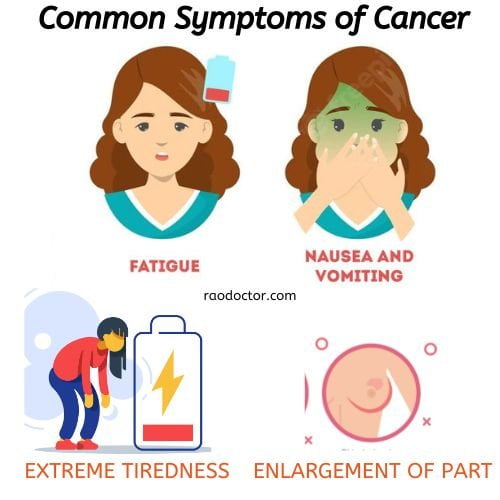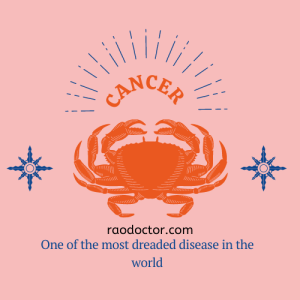Cancer Basics: 10 Signs of Cancer You Shouldn’t Ignore to live a better life
Listen to this article-
What is Cancer?
Cancer is one of the most dreaded diseases in the world. It is a disease that starts when cells in your body begin to grow uncontrollably. These cells can then spread to other parts of your body through blood vessels or the lymphatic system.
As the cancer grows, it can affect nearby tissue and organs. The spread of cancer to other parts of the body is what your doctor calls as metastasis.
The term ‘cancer’ means a group of diseases that all affect the body’s cells in different ways. There are many different types of cancer, but they usually start in the cells that line various parts of the body. Other cancer types can start in nearly any part of your body.
Each type of cancer has its own unique features, but they all have something in common: they are uncontrolled growths of abnormal cells that can spread to other parts of the body and may eventually lead to death.
What causes Cancer?
At its most basic level, cancer is an abnormal growth of cells that can eventually spread to other parts of the body and affect health. Your body’s immune system is designed to fight off invading microbes and viruses, as well as abnormal cells.
However, sometimes the immune system makes a mistake and begins attacking healthy cells. This results in a type of new growth called a neoplasm. In simple terms, it is called a tumor.
Cancer is a general term that describes several different diseases. Each one has its own causes, symptoms, and treatments.
What are the risk factors that can lead to someone getting Cancer?
Although the exact cause of cancer is unknown, it is clear that environmental and genetic factors play a role in its development. Cancer is a disease that starts when cells in your body begin to grow uncontrollably.
These cells can then spread to other parts of your body through blood vessels or the lymphatic system. As the cancer grows, it can affect nearby tissue and organs.
Some people have a higher risk of developing cancer due to their genes or lifestyle. These factors can increase your risk:
- Age – Cancer can happen at any age from a newborn child to an elderly person. However, some are common in old age, for e.g.,
- Prostate cancer in men,
- uterine cancer in post-menopausal women,
- blood cancer in an infant or child.
- Gender- Some cancers are common in women- e.g., breast cancer.
- Family history – Some cancer patients may have a family history- e.g. Hereditary breast and ovarian cancer (HBOC)
- Radiation exposure – e.g., Multiple myeloma, blood cancer, lung cancer.
- Tobacco smoke exposure – e.g., lung cancer, stomach cancer.
- Drinking alcohol – e.g., liver cancer, pancreatic cancer, cancer of large intestine
- Unhealthy diet – eating more of processed foods can lead to cancers of intestines
- Lack of physical activity – there is evidence to show that a lack of physical activity can lead to cancer such as bladder cancer.
- Aging- this can cause cancer of all categories as mentioned above.
High-fat, fiber diets may increase the risk of many cancers including bowel, lung, prostate and uterine cancers.
Source: – Better Health Channel
How to know if you are going in for cancer?
Diagnosing cancer can be a difficult process at the best of times. Unless you are fortunate enough to see a specialist and have tests or biopsies after a visit, you may not know whether your symptoms are related to cancer.
Instead, the difficulty involves differentiating between benign (non-cancerous) and malignant (cancerous) tumors. For example, if you have a lesion that is most likely cancer, how do you know for sure?
Which tests should you undergo? And what does this mean for your future? Fortunately, there are several indicators that indicate when something might be wrong.
If any of these 10 signs of cancer occur as frequently as they should in the population at large, it is time to get checked by a doctor.
1. Cancerous Tissue Can Cause Enlargement
Cancerous tumors can grow and invade the surrounding tissue. At times, the presence of a cancerous tumor can lead to a visible change in the size of a part of the body. For example, a breast cancer tumor may become large enough to be felt as a lump under the breast tissue.
I saw breast cancer as big as a small cauliflower in an elderly woman when I was in the second and third year of my medical college. In fact, my long case during the final year exams of my MBBS was a breast cancer one!
Similarly, a lung cancer tumor may cause the lung to become larger, which can be detected on a chest X-ray. If a tumor enlarges further and presses on nearby structures, it can lead to symptoms, such as pain in the affected area and swelling. In the lungs it can cause chest pain. In the brain, it can cause persistent headaches.
In one of my earlier articles on Prostate Disease, I described what prostate cancer looks like. You can read it here-Prostate Problems.
2. Nausea or Loss of Appetite
Nausea and loss of appetite are among the most common symptoms of cancer. Nausea is usually caused by many different kinds of cancers, including cancers of the stomach and bowels, as well as cancers of the blood, lungs, liver, or pancreas.
Loss of appetite, on the other hand, can be a symptom of cancers of the stomach, pancreas, liver, and kidneys.
Both nausea and loss of appetite are caused by rising levels of certain hormones in the body, including the hormones that are produced during stress. For example, high levels of hormones such as serotonin, cholecystokinin, and gastrin can cause nausea and vomiting in cancer patients.
3. You Are Tired All the Time
Cancers can cause fatigue, especially cancers of the blood, kidneys, and certain lymph nodes [e.g., Hodgkins Lymphoma].
Fatigue is a common side effect of cancer treatment, but it can also be a sign of cancer itself. More often, fatigue is a symptom that can help us identify a problem before it gets worse.

4. New Lump or Growth on or in the Body
A lump or growth in the body can be a sign of cancer. The most common places where you can find such growth are in
- the breasts,
- the thyroid gland,
- the liver, the lungs,
- the colon,
- the kidneys, and
- the lymph nodes.
- the skin
But it can also be indicative of other diseases, such as benign cysts and infections.
5. Changes In Color or Texture of Skin or Tissue
Changes in the color or texture of the skin or tissue can be a sign of cancer. This can include the appearance of a new mole on the skin, or changes in the size or color of an old mole. In addition, it can also be a sign of infection, or even a rare genetic condition.
6. Pain, Discomfort, or Tightness
Pain, discomfort, or tightness in a certain part of the body can be a symptom of cancer. This can be due to either a cancerous tumor or the enlargement of a nearby structure that has become affected.
7. Diagnostic tests for cancer
If you experience any of these signs, you should get a medical exam as soon as possible. A doctor will perform a physical examination to check for things like swelling, lumps, and changes in the skin.
They will also perform blood tests to look for signs of cancer or other diseases. If a doctor finds something that’s not normal, they may recommend other tests, like imaging scans or biopsies, to learn more.
8. Cancer marker tests
If the doctor suspects you may have cancer but can’t tell for sure, they may also order a cancer marker test. These tests measure certain substances in your blood that are commonly found in people with certain types of cancer.
Blood markers for confirming various cancer-
Popular cancer marker tests for various types of cancer are listed below-
- Prostate cancer: Prostate specific antigen (PSA)
- Breast cancer: Human epidermal growth factor receptor 2 (HER2)
- Colorectal cancer: Carcinoembryonic antigen (CEA)
- Ovarian cancer: Cancer antigen 125 (CA 125)
- Pancreatic cancer: Carcinoembryonic antigen (CEA) also known as CA 19-9
- Lung cancer: Cytokeratin fragment (CYFRA 21-1)
- Liver cancer: Alpha-fetoprotein (AFP)
- Kidney cancer: Tumor markers such as Alpha-fetoprotein (AFP), Beta-2 Microglobulin (B2M), and heat shock proteins (HSPs) are associated with kidney cancer.
- Bladder cancer: Cytokeratin 19 Fragments (CYFRA 21-1), NMP22, and Urinary Tissue Polypeptide Antigen (UTPA) are considered tumor markers for bladder cancer.
- Urethral Cancer: Cancer antigen 125 (CA 125) and cancer antigen 15-3 (CA 15-3) are the most common tumor markers used to diagnose urethral cancer.
9. X-ray, Ct-scan or ultrasonography-which tests are good to detect cancer?
X-rays, CT scans, and ultrasound are the tests that doctors use to examine the inside of the body. CT scan and MRI help to detect cancer in the bones and other tissues. They work by emitting high-energy rays of radiation through the body.
A computer then uses the patterns created by the rays to produce images of the inside of your body. CT scans use X-rays as well, but also add a chemical dye that helps to highlight certain tissues.
10. What is biopsy and how does it help to detect cancer?
A biopsy is a medical procedure that is used to remove a small piece of tissue for examination in a laboratory. The sample can be analyzed for the presence of cancer cells and other abnormalities.
A biopsy is a common way for doctors to diagnose several types of cancer. There are two major types of biopsies that may be performed: A core biopsy and a surgical biopsy. A core biopsy takes a small sample of tissue using a special device that is inserted into the body, while a surgical biopsy requires a surgeon to remove a sample of tissue.
The second one- surgical biopsy- consists of removing the whole tumor and sending it for a procedure called histopathology. This procedure helps the surgeon to know what type of that particular cancer is and then determine what is the best line of treatment for that cancer.
If your doctor suspects that you may have cancer, they may recommend having a biopsy to confirm the diagnosis.
Types of Biopsies that your doctor may advise-
- Fine needle aspiration biopsy
- Core needle biopsy
- Punch biopsy
- Surgical biopsy
- Skin biopsy
- Endoscopic biopsy
- Laparoscopic biopsy
- Image-guided biopsy
For an in-depth knowledge on cancer, click this link – Mayo Clinic on Cancer
Now that we have learned in general about cancer, we will learn about 7 common cancers that affect both men and women in my next article.
Final words-
If you have found this article useful, could please share this article with all your friends and group. Better still, if you have Twitter account, you can click the link below to share it-
Cancer Basics: 10 Signs of Cancer You Shouldn't Ignore to live a better life Share on XDisclosure–
Some of the links used in this article are affiliate links. i.e., if you sign up for their paid program or make a purchase, I will get a commission, at no extra cost to you. Please be rest assured that I only recommend software/ products I genuinely believe in, and trust to be good for you too.


